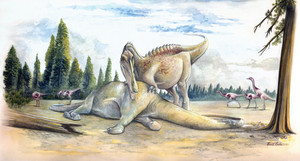
Renata Cunha
Spinosaur: Some forms of the largest carnivorous dinosaur were adapted to the terrestrial…Renata CunhaIn the popular imagination, the 13-meter-tall, 7-ton Tyrannosaurus rex is the ultimate embodiment of a ferocious dinosaur. In recent years, however, a series of studies have focused on more appropriately characterizing the anatomical attributes, and especially the way of life, of the spinosaurs—a group of dinosaurs, also carnivores, whose largest specimens towered over the “king of the tyrannus lizards.” The gigantic spinosaur had an elongated skeleton, like that of a crocodile, and a series of sail-shaped vertebrae on its back. In the 2001 film Jurassic Park III, one of these “spine lizards,” which could stand as high as 15 meters and weigh perhaps 20 tons, wins a battle with a T. rex. But such a rivalry is nothing more than fiction. The two dinosaur groups did not coexist in either time or space.
But their massive size is not the only reason that the spinosaurs have recently become an interesting subject of study. A number of papers published in the present decade, such as an article by researchers from the University of Chicago in the September 2014 issue of the journal Science, indicate that the spinosaurs appear to be the only representatives of a lineage of dinosaurs adapted to both terrestrial and aquatic environments near coastlines, rivers or lakes. Certain bone features of the species Spinosaurus aegyptiacus, such as the crocodilian snout, tapering teeth and shovel-shaped feet, as well as remains of fish found in their intestines, suggest that this family of dinosaurs was able to swim and hunt in an aquatic environment. A recent study by paleontologists from the Federal University of Rio Grande do Sul (UFRGS) corroborates this idea through another type of evidence.
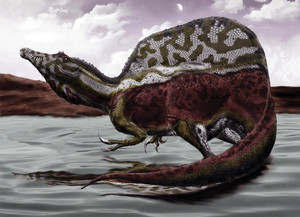
Durbed/Wikimedia Commons
… and aquatic environments of the CretaceousDurbed/Wikimedia CommonsStatistical calculations suggest that the chances of a “spine lizard” having inhabited aquatic environments were significantly greater than those of an abelisaurus or a carcharodontosaurus—two families of large carnivorous dinosaurs known to be terrestrial and more or less contemporaneous with the spinosaurs. “According to our statistical tests, only the spinosaurs exhibited a positive correlation with coastal environments of the past,” says César Schultz of UFRGS, a coauthor of the study, whose findings were published in the journal PLOS One on February 1, 2016. “But they were likely not exclusive to habitats near water. Like the abelisaurs and carcharodontosaurs, they probably also inhabited terrestrial environments.” The three dinosaur groups reached their pinnacle during different time spans in the Cretaceous period, between 145 and 66 million years ago, and inhabited lands on the ancient southern supercontinent Gondwana that are now North Africa and South America, including the Brazilian Northeast.
The work of the researchers involved collecting the available data on fossil occurrences of the three dinosaur families as of late 2014 in the Paleobiology Database, an international database of more than 58,000 references on paleontological findings. After separating out the most dubious records, they came up with a total of 198 sites on the globe where reasonably reliable evidence of at least one specimen of a spinosaur, abelisaur or carcharodontosaur has been found. “The sites could feature anywhere from just one fossil from one family to several specimens of the three dinosaur groups,” says Marcos Sales, principal author of the paper, who is a doctoral candidate advised by Schultz.
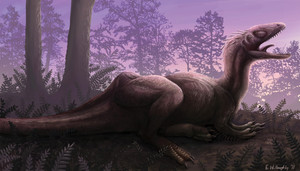
Emily Willoughby/Wikimedia Commons
Carcharodontosaurus: Group of carnivores with sharp teeth, similar to those of a shark, had terrestrial habits. Above, illustration of the species Concavenator corcovatusEmily Willoughby/Wikimedia CommonsThe spinosaurs were the occurrence champions, with 81 records. Next came the abelisaurs (72) and the carcharodontosaurs (66). Of the known sites containing spinosaur fossils, 16 were in geological layers that represented coastal environments of the Cretaceous, and 65 were in records associated with terrestrial habitats located in the innermost environs of the ancient continents. The database also contains information on abelisaurus and carcharodontosaurus fossils found in sediments of coastal origin, although in lesser numbers than for the spinosaurs (three records for the first dinosaur group and 10 for the second). “But, according to our statistical tests, the fossil occurrences of these two families in coastal paleoenvironments were probably chance happenings, due to some random factor,” Sales comments.
Chi-squared test
Finding fossils of spinosaurs, or of any dinosaur or vertebrate, in sediments associated with ancient lakes or coastal areas does not necessarily mean that this type of habitat was one of their ecological niches. The animals may have lived and died in the continental interior, and their fossils could have simply been transported to a coastal region. In theory, sedimentary processes and chance—rather than the hypothesis that they actually lived in or near water—may be accountable for the existence of any given number of spinosaur remains in geological layers representative of aquatic habitats during the Cretaceous. Scientists expect that there are many more records of dinosaur fossils associated with ancient terrestrial environments than of ones linked to aquatic habitats. The sedimentation process, which is necessary for fossil formation, is much more common in continental interiors removed from large bodies of water than in coastal or fluvial areas. “There is much more space in the interior than along the coast, and this, of course, likely skews the record of many groups of terrestrial animals,” Sales says.
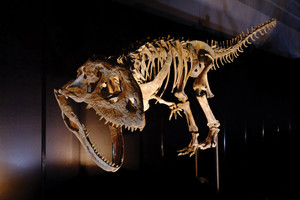
Kumiko/Wikimedia Commons
Abelisaurus: Reconstructed skeleton of Majungasaurus crenatissimus, a species of the group of terrestrial carnivorous bipeds having small anterior limbsKumiko/Wikimedia CommonsOne way of circumventing this problem is to use statistical methods that enable a more precise analysis of the data. In their dinosaur research, the UFRGS paleontologists used a mathematical tool called the chi-squared test. This approach is generally used to determine whether the variables of a dataset are independent—in other words, if their values vary randomly, by chance—or show some kind of association, a causal link, between them. In the case of the dinosaurs, the objective was to ascertain whether the number of fossils of each group found in deposits representing coastal (or terrestrial) environments of the Cretaceous can be interpreted as evidence that such a reptile actually inhabited those places, or should be viewed as a freak of nature. For coastal environments, only the set of spinosaur occurrences displayed the robustness necessary to pass the test. Abelisaurs and carcharodontosaurs exhibited statistical affinities with exclusively terrestrial habitats.
The work of Sales and Schultz provides one more type of clue that the “spine lizards” may have exhibited semiaquatic habits during the Cretaceous. “The study is interesting and it corroborates that idea,” says Alexander Kellner, a paleontologist at the National Museum of the Federal University of Rio de Janeiro (UFRJ). “But the subject is extremely controversial.” According to Kellner, who discovered spinosaur species such as Angaturama limae and Oxalaia quilombensis in Cretaceous sediments in Araripe Bay, the geological layers where many fossils of this dinosaur family are found are not always well demarcated. Therefore, it may be difficult to associate them accurately with marine environments of the distant past.
Crocodile with ears
Extinct terrestrial form of a reptile that lived in inland São Paulo State may have had a large outer ear
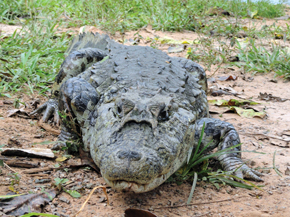
Lauro Sirgado/Wikimedia Commons The broad-snouted caiman has a “lid” of soft tissue where it likely once had earsLauro Sirgado/Wikimedia Commons
An extinct group of carnivorous crocodiles typical of South America, known as the baurusuchids, probably had ears similar to those of the mammals of today, as well as a more refined auditory system than paleontologists had imagined. That is the idea proposed by researchers at Sao Paulo State University (Unesp) and Canada’s McGill University in a paper published in the Journal of Anatomy on February 4, 2016. According to the authors, these reptiles, which lived in terrestrial environments during the Upper Cretaceous epoch, between 100 and 66 million years ago, had a large outer ear, much bigger than that of its ancestors or of present-day alligators and crocodiles. “Having the ability to hear sounds in the air was likely important for the origin and evolution of crocodyliforms,” says paleontologist Felipe Montefeltro, a professor in the Department of Biology and Animal Science at Unesp’s Ilha Solteira campus and principal author of the study. “At that time, some of them lived outside of the water.” Good hearing makes it easy to do things such as locate prey on dry land.
As crocodiles were leaving dry environments and migrating to aquatic surroundings, their outer ear likely underwent anatomical modifications and assumed other functions. “The appearance of new types of crocodyliforms was associated with a dramatic alteration in the outer ear,” says biologist Hans Larsson of McGill University. As these reptiles became amphibians, in place of the old ears they likely began to exhibit a kind of lid consisting of soft tissue–a very functional anatomical feature in their new aquatic habitat. Today all crocodile and alligator species live close to water. Most of them are found along riverbanks, although marine forms do exist.
Montefeltro came to his findings by analyzing collections of baurusuchid fossils—which are abundant in the state of São Paulo—and of other extinct forms of crocodiles, and dissecting specimens of alligators belonging to living species, such as the broad-snouted caiman (Caiman latirostris). The anatomical structure analyzed in greatest detail by the researchers was the meatal chamber, the technical name for the resonance box that forms the outer ear of these reptiles. The work was done in connection with a thematic project on the origin and evolution of the dinosaurs and other reptiles, coordinated by Max Langer of the University of São Paulo (USP), Ribeirão Preto campus.
Project
The origin and rise of dinosaurs in Gondwana (late Triassic – early Jurassic) (nº 2014/03825-3); Grant Mechanism Thematic Project; Principal Investigator Max Langer (USP-Ribeirão Preto); Investment R$1,706,876.45 (entire project).
Scientific articles
SALES, M. A. F. et al. The “χ” of the matter: Testing the relationship between paleoenvironments and three theropod clades. PLOS One. February 1, 2016.
MONTEFELTRO, F. C. et al. The evolution of the meatal chamber in crocodyliforms. Journal of Anatomy. February 4, 2016.